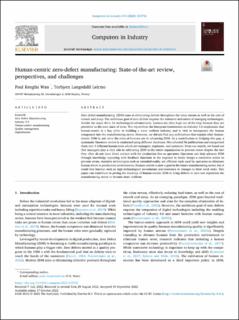| dc.contributor.author | Wan, Paul Kengfai | |
| dc.contributor.author | Leirmo, Torbjørn Langedahl | |
| dc.date.accessioned | 2023-09-05T13:34:22Z | |
| dc.date.available | 2023-09-05T13:34:22Z | |
| dc.date.created | 2022-10-18T08:46:49Z | |
| dc.date.issued | 2022 | |
| dc.identifier.citation | Computers in industry (Print). 2022, 144, 103792. | en_US |
| dc.identifier.issn | 0166-3615 | |
| dc.identifier.uri | https://hdl.handle.net/11250/3087564 | |
| dc.description.abstract | Zero defect manufacturing (ZDM) aims at eliminating defects throughout the value stream as well as the cost of rework and scrap. The ambitious goal of zero defects requires the extensive utilization of emerging technologies. Amidst the major drive for technological advancement, humans are often kept out of the loop because they are perceived as the root cause of error. The report from the European Commission on Industry 5.0 emphasizes that human-centric is a key pillar in building a more resilient industry and is vital to incorporate the human component into the manufacturing sector. However, we did not find any publications that explain what human-centric ZDM is, nor what the roles of humans are in advancing ZDM. As a contribution to bridging this gap, a systematic literature review is conducted using different databases. We collected 36 publications and categorised them into 3 different human roles which are managers, engineers, and operators. From our search, we found out that managers play a vital role in cultivating ZDM in the entire organization to prevent errors despite the fact they often do not have direct contact with the production line as operators. Operators can help advance ZDM through knowledge capturing with feedback functions to the engineer to better design a corrective action to prevent errors. Assistive technologies such as extended reality are efficient tools used by operators to eliminate human errors in production environments. Human-centric is now a goal in the future manufacturing sector, but it could face barriers such as high technological investments and resistance to changes in their work tasks. This paper can contribute to paving the roadmap of human-centric ZDM to bring defects to zero and reposition the manufacturing sector to become more resilient. | en_US |
| dc.language.iso | eng | en_US |
| dc.publisher | Elsevier | en_US |
| dc.rights | Navngivelse 4.0 Internasjonal | * |
| dc.rights.uri | http://creativecommons.org/licenses/by/4.0/deed.no | * |
| dc.title | Human-centric zero-defect manufacturing: State-of-the-art review, perspectives, and challenges | en_US |
| dc.title.alternative | Human-centric zero-defect manufacturing: State-of-the-art review, perspectives, and challenges | en_US |
| dc.type | Peer reviewed | en_US |
| dc.type | Journal article | en_US |
| dc.description.version | publishedVersion | en_US |
| dc.rights.holder | © 2022 The Author(s). Published by Elsevier B.V. | en_US |
| dc.source.volume | 144 | en_US |
| dc.source.journal | Computers in industry (Print) | en_US |
| dc.identifier.doi | 10.1016/j.compind.2022.103792 | |
| dc.identifier.cristin | 2062264 | |
| dc.source.articlenumber | 103792 | en_US |
| cristin.ispublished | true | |
| cristin.fulltext | original | |
| cristin.qualitycode | 2 | |

